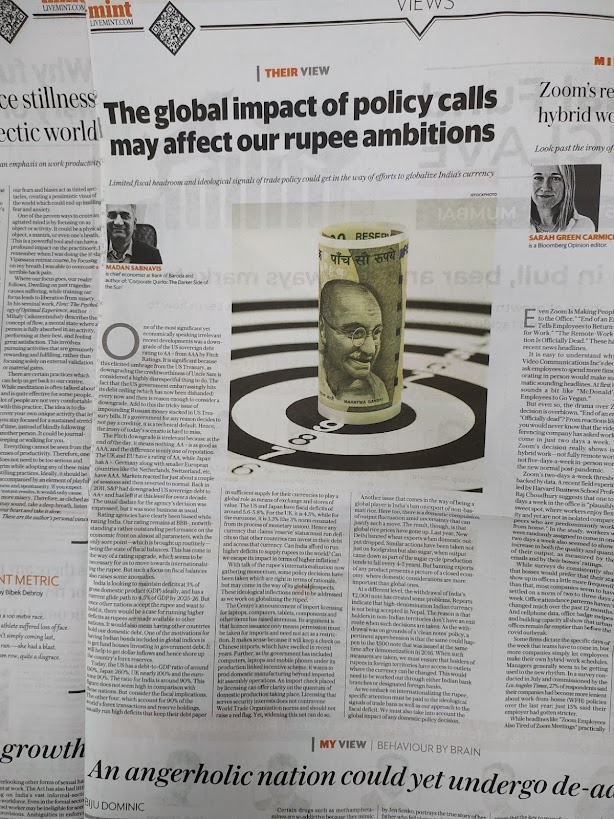India aspires to make the rupee international. Meanwhile, the talk of de-dollarisation has picked up momentum, thus fostering dialogue on use of domestic currency for bilateral trade. The recently-concluded Brics meet was the latest impetus in this direction.
The Brics concept is otherwise a failed concept. This is so because two of the member-nations are treated as a pariah and there are deep trust deficits with a few others. India stands tall here as not just the fastest-growing democracy in the world but also as a nation that retains fairly strong diplomatic ties with all other nations. But the trust deficit with China has been rising though it is a strong trade partner as a source of imports for India (the government would like to curb this).
It is against this background that one can look at the relevance of Brics. Global institutions have lost their importance with the retreat of globalisation and more inward-looking policies are being pursued by most nations. The World Trade Organization (WTO) has lost its relevance as the rules are not obeyed by member nations. The International Monetary Fund is less important today as economies have become more resilient and it is only mismanaged economies like Argentina (from among the Brics grouping) that seek its assistance. Even at the political level, the UN has failed to sort out differences between nations.
Russia has become a pariah—oil and gas are the last vestiges of its link to the world. So, countries would have issues trading with it, given payments mechanisms have been choked. China is on the decline and the China-plus-one policy is in the minds of all investors. Fissures in the model have surfaced and it is still a large player given its size; but, there is still a tendency among leading economies to feel discomfort when it comes to deeper relations with the country. A managed currency that gave it a lot of advantage on the global trade platform is no longer acceptable to others at a time when the world is stagnating for the second successive year. South Africa does not have a reputation for prudence and is too small relative to other nations to provide any pillars of support for the global economy. That leaves India and Brazil as the ones that have to drive the agenda.
It is not surprising that more countries have been seeking entry into the group and a few have already been confirmed as members and will formally join next year. Intuitively, getting more countries in as members makes decision-making difficult as there will more divergent views. Invariably, countries would look to align with one of the more powerful members—it not difficult to guess that China would enjoy the majority here too. Even if not aligned, the raison d’être of joining the group would be to draw benefits without losing much in return.
Forming such economic groups makes sense if there is openness on trade and investment apart from labour movement. Otherwise, it would just mean more meetings that do not really deliver any tangible benefits. It is true that the coming together of more nations would largely be from the emerging world and, hence, there is scope to further the talks on economic cooperation. However, it would also mean that there should be countries with economic size that can offer India something in return.
With the dedollarisation talk gathering steam, one thought is the possible acceptance of local currencies for intra-grouping trade. But, here, the biggest challenge is China which will always push the yuan. It already has such ties with other countries—trading in yuan—as it has been trying to make it a universal currency. This will not be acceptable to India for sure and has been rejected already at the conceptual stage.
One area which needs to crystallise is the flow of finance. The Brics Bank (New Development Bank) is already operational. But it needs to grow in stature at a faster pace to make a real difference. The idea behind the New Development Bank was to provide an alternative for the developing world to the World Bank, where it is believed that the Western dogma is part of the package and comes in the way of economic independence of the borrower. This can be a big advantage here when we are talking of internationalisation of the rupee—the NDB could take funds in the domestic currencies of the members and this could then be loaned to others who can use the same for buying goods from nations that accept these currencies. This will be a pragmatic way of leveraging the Bank.
While talks on trade can carry on in the normal course, compromise solutions are the best that can be expected. Without sounding pessimistic it can be said that if the five nations have not managed much so far, there is little reason to be positive with two of them under a cloud. Also, as the new potential members would be from the lower income bracket, there may not present an optimal alternative. But, the NDB route could be the way out for India.




